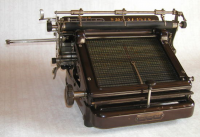








The first practical Japanese typewriter was invented by Kyota Sugimoto in 1929.Out of the thousands of kanji characters, Kyota's original typewriter used 2,400 of them. He obtained the patent rights to the typewriter that he invented in 1915. Until the popularization of word processor technology, the Japanese typewriter contributed greatly to increased efficiency of document preparation at Japanese companies and government offices.
Kyota Sugimoto was a Japanese inventor who developed the first practical Japanese typewriter. He received the Blue Ribbon Award and the Small Asahi Ribbon. Out of the thousands of kanji characters, Kyota's typewriter used 2,400 of them.
Although many Japanese desired to use typewriters, which were in wide use in the early 20th century in the United States and Europe, the structure of foreign-made typewriters, which need relatively few characters, could not be adapted to Japanese text which uses more complicated kanji.
In order to adapt typewriters to kanji, which has a large number of characters, Kyota Sugimoto carefully considered the nature of this writing system, including the frequency of use of characters used in public documents. The 2,400 characters chosen as a result were arranged by classification on a character carriage, and the chosen character was raised by a type bar that could move forward and backward and left and right. The character was then typed against a cylindrical paper supporter. The Japanese typewriter with this innovative structure was patented by Mr. Sugimoto in 1929.
Until the popularization of word processor technology, the Japanese typewriter contributed greatly to increased efficiency of document preparation at Japanese companies and government Offices.